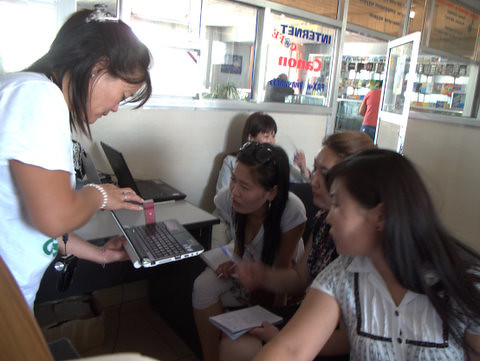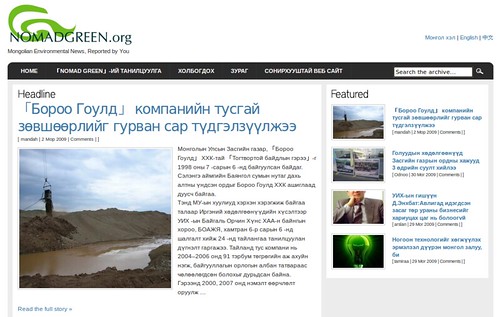Although it is half a month already since Nomad Green's latest two workshops in Ulaanbaatar, Mongolia, I still remember clearly the enthusiasm and passion I felt from new participants of Nomad Green (Mongolian Environmental Information Program, supported by Rising Voices and MTF Taiwan)
Three months passed after Nomad Green's first 4 workshops in Ulaanbaatar, the capital of Mongolia. In early July, the core team of Nomad Green(Portnoy, Otgoo, Odnoo) finally decided to hold another two workshops on July 29 and 30. And this time, instead of covering broad range of Mongolian environmental issues, such as air pollution, water pollution, deforestation, mining…, we wanted to focus on special topics that matters very much to people who live in this over-crowded therefore fragile city.
So each of the two workshops has its own special topic with a relative bus trip to visit the exact area. The topic of the first workshop on 7/29 is “Tuul River”, the mother river that provide water usage to about 60% of Mongolian population(which is 1.5 million people) who lives in downtown Ulaanbaatar and the yurt district around the downtown. The other topic for the second workshop on 7/30 is “Waste management”, which is a major concern for such a fastly growing city.
Instead of separating one workshop into two days as last time we did in May, we decided to utilize a full day from 9:00 in the morning to 8:00 in the evening for each workshop because July is much warmer than May, and the sunset also comes a lot later until 9:00 in the evening, so we won't have to ask our participants to come twice and it is safer for participants when they return home in late evening. (Some of them live very far away from the downtown.)
Each Nomad Green workshop can be divided into five major parts:
1. mission explanation
2. social web introduction and practice
3. speech on special topic
4. site exploration
5. discussion and presentation
Most parts were the same as the last four workshops in May, except that, first, we skipped facebook, youtube, flickr, but concentrated on wordpress(which is the platform Nomad Green is on) and twitter. The reason was that we only had limited time and twitter is the simplest one to teach. As a country of 2.8 million people, the participants of our workshops were all shocked to know that there are some people on twitter whose tweets are read by up to 2 million at the same time. (I used Shaq O'nell's twitter account as the example)
Second, since we had decided two special and clear targets(Tuul river and waster management in UB) to report, so for each workshop we arranged a special talk by the expert of that topic and one bus to take participants together to the exact spot.
The two visits, one to the near-by basin of Tuul river, the other to the landfill site of UB, were really very helpful for all of us to grasp a fuller picture of each issue. We saw how the watercourse was changed by the mining company which caused serious decrease on water volume. We also witnessed how the constructions built in the basin was corroding the river. According to the estimation from UB city goverenment, the utmost amount of people that Tuul river can support is less than 2 million, and there are already 1.5 million. Since Tuul river and the underground water (that also come from the river) are the only water resources to support the whole population in UB, the protection of Tuul river is extremely vital.
The visit to UB landfill site was also an important experience to all participants since none of them had ever visited the place before and didn't know where their trashes go. The landfill site was built with the support from Japanese governement so the facilities are all new and really good, however, the logistics of waste transportation, the system of recycling, the regulation to reduce urban trash, and the citizens’ awareness to the issue are not matured yet, so the waste management issue has been the most difficult problem to city government for many years and still is.
During our visit, we also met the people whose lifes are depending on collecting and sorting out trashes. Many of them are kids, and the only economical sources of their families. Nomad Green participants and future citizen journalists interviewed some of them under the supervision of the manager of landfill site. One leader of the group of trsh pickers told us that many people and media journalists regarded them as “trash eaters” because they never really know them and build stories based on their appearances, but in fact, picking trashes is just their job, and they are just like anyone else: they are clean in clean clothes when they go to the downtown UB. She was very diappointed whenever she read biased and stereotyped articles about them (trash pickers at the landfill site).
Many participants finished their reports soon after returning to the internet cafe. Some of their posts are already posted on Nomad Green.
Two major targets for Nomad Green to meet if we want to have bigger influence are 1. to translate Mongolian articles into English and Chinese, more 2. to kick off workshops in other cities of Mongolia. The editors’ team is working on the targets.
Flickr album of the latest two workshops:
http://www.flickr.com/photos/workingman/sets/72157621804697043/
Please follow the twitter account of Nomad Green:
http://twitter.com/nomadgreen/





